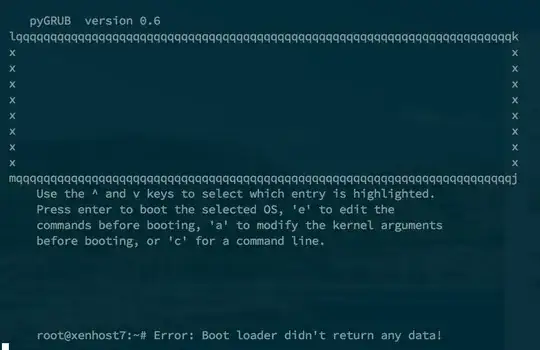I'm trying to run a Ubuntu 12.10 off a Debian 6.0.4 and Xen-4.0. I realised that pygrub might not be able to parse the menu.lst (I symlinked menu.lst to grub.cfg in /boot) and ended up with this configuration:
#
# DO NOT EDIT THIS FILE
#
# It is automatically generated by grub-mkconfig using templates
# from /etc/grub.d and settings from /etc/default/grub
#
menuentry 'Ubuntu' --class ubuntu --class gnu-linux --class gnu --class os {
insmod gzio
insmod ext2
search --no-floppy --fs-uuid --set=root 7098a9fb-df7a-4e37-841d-73641c6b79c5
loopback loop0 /sdd
set root=(loop0)
linux /boot/vmlinuz-3.5.0-27-generic root=UUID=7098a9fb-df7a-4e37-841d-73641c6b79c5 ro console=hvc0 splash quiet
initrd /boot/initrd.img-3.5.0-27-generic
}
But unfortunately pygrub is still unable to parse the configuration file and shows me the following output:

I figured that pygrub has problems with the loopback device in the menuentry. I removed the offending lines and replaced them with a straightforward configuration (similar to my other Debian Xen instances).
menuentry 'Ubuntu' --class ubuntu --class gnu-linux --class gnu --class os {
insmod ext2
set root=(hd0)
linux /boot/vmlinuz-3.5.0-27-generic root=UUID=7098a9fb-df7a-4e37-841d-73641c6b79c5 ro console=hvc0 splash quiet
initrd /boot/initrd.img-3.5.0-27-generic
}
But unfortunately this won't boot either: It shows the pygrub menu and an error message: Traceback (most recent call last):
File "/usr/lib/xen-4.0/bin/pygrub", line 704, in <module>
chosencfg = run_grub(file, entry, fs, incfg["args"])
File "/usr/lib/xen-4.0/bin/pygrub", line 570, in run_grub
img = g.cf.images[0]
IndexError: list index out of range
root@xenhost7:~# Error: Boot loader didn't return any data!
The error seems to indicate that pygrub is able to parse the data but somehow is unable to find the kernel. But the kernel exists. Fdisk also shows that /boot is on the first partition:
Disk part: 32.2 GB, 32212254720 bytes
255 heads, 63 sectors/track, 3916 cylinders
Units = cylinders of 16065 * 512 = 8225280 bytes
Sector size (logical/physical): 512 bytes / 512 bytes
I/O size (minimum/optimal): 512 bytes / 512 bytes
Disk identifier: 0x000c7dc8
Device Boot Start End Blocks Id System
part1 1 3851 30924800 83 Linux
part2 3851 3917 529409 5 Extended
part5 3851 3917 529408 82 Linux swap / Solaris
Note that booting the machine with an external kernel is not really an option since all VM's are booted via iSCSI (and we will switch to KVM at some point in the near future). The loopback device in the original grub config might also produce problems when starting up.
Any suggestions, ideas?